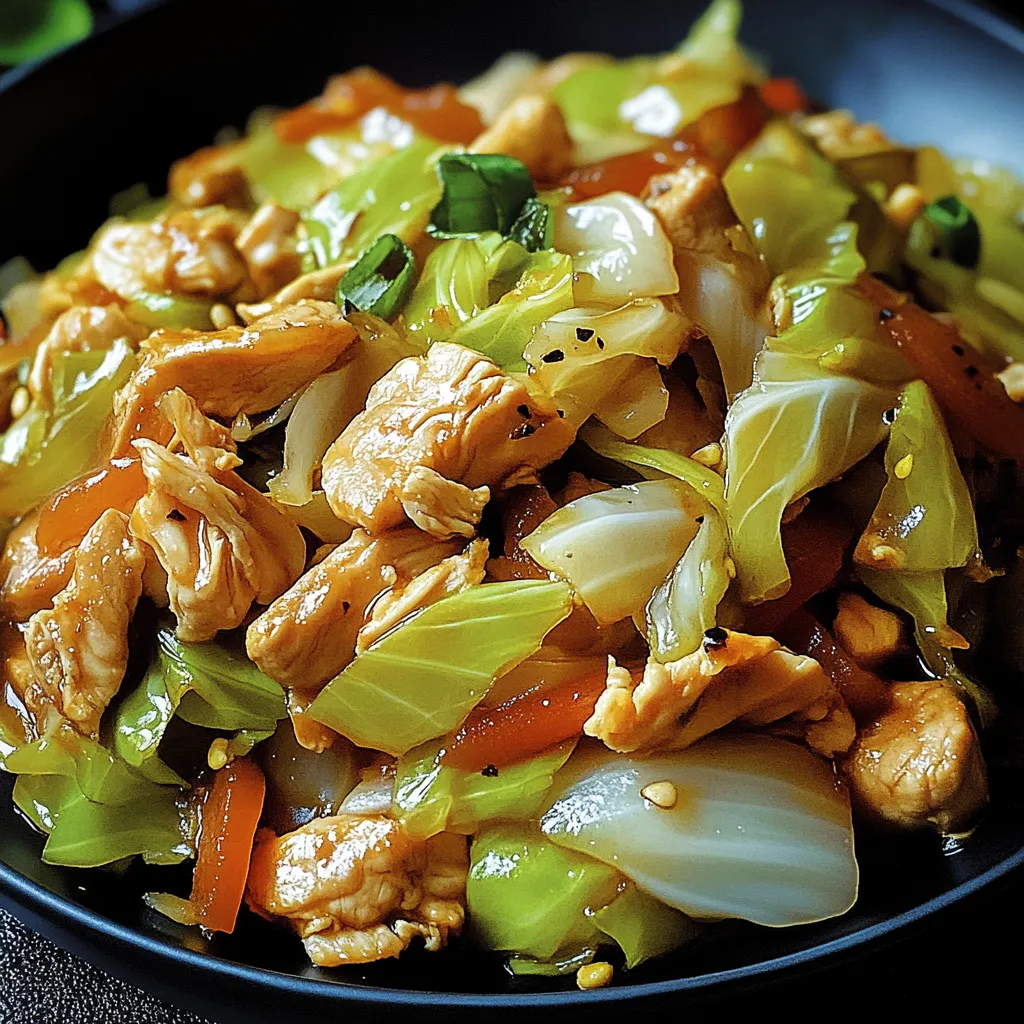 Save
Save
This Chinese Chicken Cabbage Stir-Fry combines tender chicken with crisp cabbage in a savory sauce that transforms these simple ingredients into a restaurant-quality meal in just 25 minutes. The dish strikes the perfect balance between healthy and satisfying, bringing authentic Chinese flavors to your home kitchen with minimal effort.
I discovered this recipe during a particularly busy season when my family needed quick but nourishing dinners. What started as a pantry cleanout meal has become our most requested weeknight dinner, especially when we crave something light yet satisfying.
Ingredients
- Boneless skinless chicken: Thighs offer more flavor and stay juicier than breast meat, but either works beautifully in this quick cooking method.
- Green or Napa cabbage: The backbone of this dish provides satisfying crunch and absorbs the sauce wonderfully. Napa cabbage has a milder flavor if you prefer less cabbage taste.
- Carrot: Adds natural sweetness and beautiful color contrast. Select firm, bright orange carrots for best flavor.
- Onion: Creates the aromatic foundation. Yellow onions work best, but red adds a pretty pop of color.
- Vegetable or sesame oil: Sesame oil adds authentic Asian flavor but can be strong for some palates. Regular vegetable oil works perfectly.
- Garlic and ginger: These aromatics are non-negotiable for authentic flavor. Fresh is vastly superior to powdered in this application.
- Soy sauce: Provides the savory umami base for the sauce. Look for naturally brewed varieties for best flavor.
- Oyster sauce: This thick, deeply flavored sauce adds complexity that cannot be replicated. Find it in the Asian food section.
- Rice vinegar: Adds brightness and balances the rich flavors. Unseasoned rice vinegar works best.
- Hoisin sauce: Optional but adds wonderful sweetness and depth. Consider it the Chinese equivalent of barbecue sauce.
- Cornstarch: Creates that restaurant quality glossy thickness in the sauce that coats everything beautifully.
- Crushed red pepper flakes: Adjust according to your heat preference or omit entirely for a mild version.
Step-by-Step Instructions
- Prepare the Sauce:
- Combine all sauce ingredients in a small bowl and whisk until cornstarch is fully dissolved. This step ensures no cornstarch lumps form in your finished dish. The sauce should appear slightly cloudy but uniform in texture.
- Cook the Chicken:
- Heat your wok or large skillet until very hot before adding oil. This prevents sticking and promotes that coveted wok hei flavor. Add thinly sliced chicken in a single layer, allowing it to sear undisturbed for 30 seconds before stirring. Cook just until no pink remains about 4 minutes. The chicken will finish cooking when returned to the sauce later.
- Sauté the Aromatics:
- Add the remaining oil to the same pan, keeping all those flavorful chicken bits. Quickly add garlic and ginger, stirring constantly to prevent burning. These delicate aromatics need just 30 seconds to release their fragrance. Add onions and continue stirring for another minute until translucent but still firm.
- Cook the Vegetables:
- Add cabbage and carrots, tossing frequently to coat with the aromatic oil. High heat is crucial here to achieve the proper stir fry effect without overcooking. Vegetables should remain bright in color and maintain some crispness. This quick cooking preserves nutrients and texture.
- Combine Everything:
- Return the chicken to the pan and immediately pour the sauce mixture over everything. Stir continuously as the sauce thickens, which happens quickly usually within 60 seconds. Make sure every piece gets evenly coated with the glossy sauce. The cornstarch will activate with the heat, creating that signature Chinese restaurant texture.
- Finish and Garnish:
- Remove from heat while vegetables still retain some crunch. The residual heat will continue cooking everything slightly. Sprinkle with green onions and sesame seeds just before serving for fresh color and texture contrast.
 Save
Save
My family particularly loves the textural contrast between the tender chicken and the still crisp vegetables. My daughter, who typically avoids cabbage, happily devours this dish and has even requested it for her birthday dinner last year. Something about the flavorful sauce transforms ordinary cabbage into something truly craveable.
Meal Prep Magic
This stir fry reheats beautifully, making it ideal for meal prep. Store in airtight containers for up to three days in the refrigerator. The flavors actually intensify overnight, though the vegetables will soften somewhat. For best results when reheating, use a skillet rather than microwave to restore some of the textural elements.
Perfect Pairings
While this dish shines with simple steamed rice, consider serving it with brown rice for added nutrition or cauliflower rice for a lower carb option. For a complete Chinese restaurant experience at home, pair with egg drop soup or hot and sour soup as a starter. Want to stretch the meal further? Serve alongside vegetable spring rolls or a simple cucumber salad dressed with rice vinegar and sesame oil.
Customization Options
The beauty of stir fry recipes lies in their flexibility. Feel free to substitute snow peas, bell peppers, mushrooms, or broccoli for some or all of the cabbage. For a vegetarian version, replace chicken with firm tofu or double the vegetables. Those avoiding gluten can substitute tamari for soy sauce and ensure their oyster sauce is gluten free. The basic technique and sauce work with countless ingredient combinations.
Frequently Asked Questions About Recipes
- → What type of chicken works best for this dish?
Boneless, skinless chicken breast or thighs are ideal as they cook quickly and remain tender when stir-fried.
- → Can I use other vegetables instead of cabbage?
Yes, you can substitute cabbage with other crunchy vegetables like bok choy, broccoli, or snap peas.
- → How can I make this dish gluten-free?
Replace soy sauce with tamari or coconut aminos to make the dish gluten-free.
- → What can I serve this stir-fry with?
It pairs wonderfully with steamed white rice, brown rice, or noodles for a wholesome meal.
- → Can I prepare the dish ahead of time?
While best served fresh, you can prepare and store it in an airtight container in the refrigerator for up to 3 days. Reheat gently before serving.
